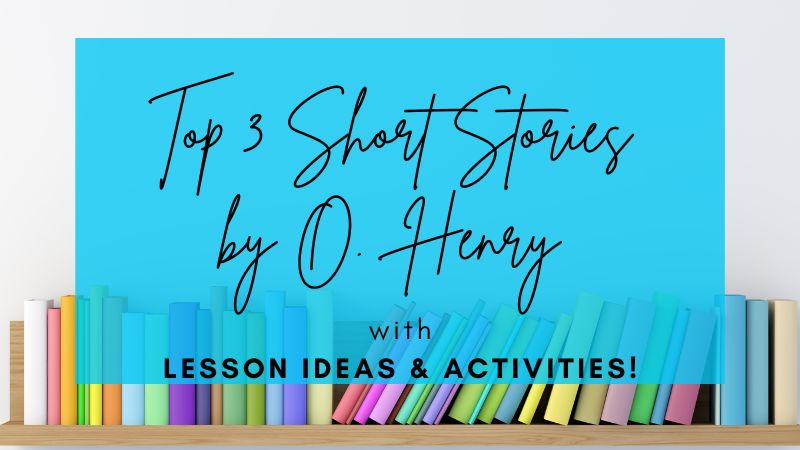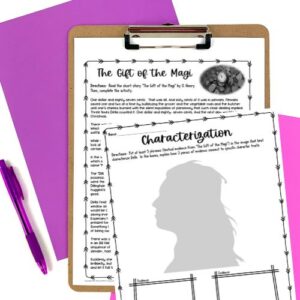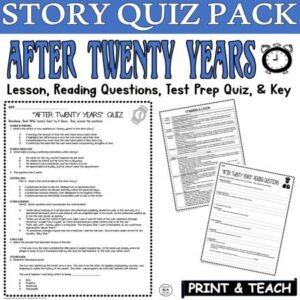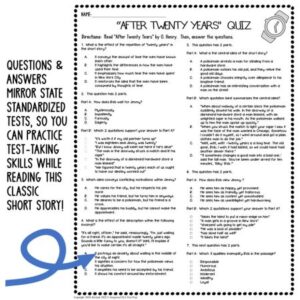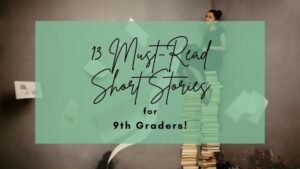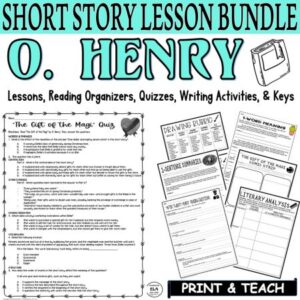Sometimes, you just need a nice, sweet, comforting, easy-to-read short story on certain days…am I right? This situation is where the short stories O Henry has written come into play!
If you have not read short stories O Henry has authored like “The Gift of the Magi,” “After Twenty Years,” or “The Cactus,” then you should! They appeal to a variety of middle and high school students, contain appropriate language and plots, and always have a fun twist!
Continue reading below for Top 3 Short Stories O Henry Lesson Ideas & Activities!!
Need help with Test Prep? Check out this FREE Pack of 3 Test Prep Activities to help students achieve success on standardized tests!
Top 3 Short Stories O Henry Lesson Ideas & Activities
1. The Gift of the Magi
Quick Summary: An impoverished couple wants to give each other surprise gifts during Christmas time. They both sacrifice greatly in order to do so. At the end of the story, there is a twist, which ends in the couple learning the true meaning of love and wisdom.
LESSON IDEAS & ACTIVITIES-Short Stories O Henry
1. Characterization- how the author depicts a character through narration (description of the characters), dialogue (what the characters say), or actions (what the characters do).
- Define the term Characterization as seen above.
- Introduce Character Traits with this FREE MY TRAITS Worksheet!
- As students are reading, identify textual evidence for each character (husband and wife).
- Use textual evidence to characterize the husband and wife with specific character traits.
- Discuss or write about the meaning of these traits: Why does the author use these traits for each character?
- Visualize each character by examining the evidence.
2. Summarizing- the process of identifying the central idea and using evidence to support the central idea.
- Provide chunks of the story to analyze versus the entire short story. This process will help struggling students understand important parts of the text more easily.
- Model how to write a 1-sentence summary before having students write a full paragraph summary. Choose 1 chunk to show students how to write the summary sentence and underline evidence to support the summary.
- Practice creating 1-sentence summaries together and locating textual evidence to support each summary.
- Provide time to allow students to write summaries independently, in pairs, or in small groups. Remember, you don’t have to assess all of the summary sentences. As an exit slip, students can provide a summary for a single chunk!
3. Literary Analysis- examining various elements of literature with a focus on meaning
- Before you begin, you will want to have a specific focus for analysis. Mood, characterization, literary elements/devices, literary lens, etc. are all ways to delve into literary analysis. If your students have never done a literary analysis before, I recommend beginning with mood or characterization.
- Now, the goal would be to teach students how to examine textual evidence, link to a literary analysis element, and explain the purpose/meaning of the information/element.
- Ex. If you are examining “The Gift of the Magi,” you might want to compare and contrast the moods from the beginning of the story to the end of the story. Be sure to explain that the mood is the emotion the author wants the audience to feel or recognize. 1) Identify textual evidence (descriptions of the setting/characters’ actions) that contribute to a specific mood. 2) Describe the mood connected to that evidence. 3) Explain how the mood relates to the meaning or message of the story.
- Click HERE to get help with teaching literary device analysis for “The Gift of the Magi!”
Want ideas for short stories with twist endings? Check out the post below!
2. After Twenty Years
Quick Summary: This classic story relays an experience of two friends who follow different life paths but plan to meet up in 20 years. When they are set to meet again, their meeting goes awry with a delightful twist!
LESSON IDEAS & ACTIVITIES-Short Stories O Henry
1. Close Reading- When it comes to reading anything nowadays, students just want to skim; however the short stories O Henry has published require more critical thinking skills!
- READING THE SHORT STORY-Read aloud with expression. You could also find an audio recording online. After each sentence, several sentences, or paragraphs, stop and think aloud about the meaning of that part.
- ANNOTATION IDEAS- 1) Vocabulary: Students can circle any words they don’t know and research the definitions or ask each other 2) Characterization: Highlight each character’s descriptions in a different color 3) Literary Devices: Put a star by any device students come across (metaphor, imagery, repetition, etc.)
- COMPREHENSION QUIZ- After students closely read and annotate, you can offer this QUIZ that mirrors state standardized tests!
2. Write in Response- So often, we forget to integrate writing into our reading instruction. Students, however, remember what they read when they write!
- Have a focus before you begin reading. If you want students to answer a question about characterization, make sure to model and annotate for evidence connected to character traits.
- Let students see a sample paragraph or outline to follow as they write!
- Provide rubrics, so students know what is expected of them.
- Here is a writing response question for “After Twenty Years:” How do the friends in the story differ from each other?
3. Teach Literary Devices/Elements- Literary devices/elements are simply creative techniques authors use to have a specific effect within a text.
Ex. Descriptive Language/Imagery: vivid, detailed language that allows the reader to visualize the events, people, and setting of a story/text
Ex. Contrast: a difference of some sort between two entities
Ex. Setting: description of the time and place
- Read O. Henry’s “After Twenty Years” together, in pairs, independently, or in small groups.
- Locate 2 examples of EACH literary device (whichever devices you want to teach).
- Examine how the literary devices affect the meaning of the short story.
- Use textual evidence to support your analysis.
- Students can write a couple of sentences or whole paragraphs; it is up to you!
See this READY-TO-TEACH bundle for “After Twenty Years” to make teaching short stories O Henry authored STRESS-FREE!
3. The Cactus
Quick Summary: The young male protagonist of the story proposes to his love interest, but he is so full of himself that he misses the most important sign of her acceptance. Their relationship falls apart and the final part of the story reveals what could have made all the difference in their relationship.
LESSON IDEAS & ACTIVITIES-Short Stories O Henry
1. Vocabulary Study- This type of activity encourages students to delve deeply into word analysis by thoroughly examining the meaning, context, etc. of a word.
- Read the short story “The Cactus” by O. Henry with your students.
- Focus on CHUNKS or PARAGRAPHS rather than the entire story.
- For each CHUNK, choose ONE word that best embodies the meaning of that CHUNK.
- Make sure to get students to explain their reasoning.
- You can always extend this vocabulary study by having students illustrate the word in some way.
2. Character’s Journey- Study a specific character from the start of the short story until the end of the story. You can use a PLOT ELEMENT chart or this EMOTIONAL JOURNEY Activity!
- Choose a character to analyze. You will want students to select one of the main characters; either the protagonist(s) or antagonist(s) would be great!
- Start by following the journey of the character by examining textual evidence.
- Locate 2 events and pieces of evidence for the beginning, middle, and end of the story.
- Then, model how to examine the evidence. How is the character depicted at the start of the story? How does the character change? What message (theme) do you think the author is trying to portray through this change or lack of change?
Need short stories to read with 9th graders? Click below!
3. Paragraph Writing- I am a HUGE fan of paragraph writing versus whole essay writing, especially for struggling readers! You can give students a focus, help them gather textual evidence, and go sentence by sentence as they write the paragraph!
- Assign a question or a focused prompt: identify character traits, discuss the theme, examine literary devices, etc.
- Help students locate textual evidence (at least 2 pieces) to assist them in answering a question and/or prompt.
- Model what a good paragraph response looks like and provide a basic outline for students to use throughout the writing process.
- Let students pair write or independently write their paragraphs, BUT make sure to let them share what they have accomplished. Using a rubric will help in this process!
Why should you teach short stories O Henry has authored?
Ultimately, we want students to be exposed to as many writing styles, stories, characters, plots, etc., as possible, so they are successful when they attempt to read anything on their own. Short stories O Henry has written are not usually very difficult to understand, and they contain timeless themes most students will engage with and find interesting! These Top 3 Short stories O Henry are MADE for the middle and high school classroom!
Thinking about teaching short stories O Henry lessons and activities? Check out the BUNDLE below for 3 short stories O Henry lessons and worksheets!
Want more ideas for Short Stories O Henry Lessons and Activities? Check out my store Kristin Menke-Integrated ELA Test Prep!

